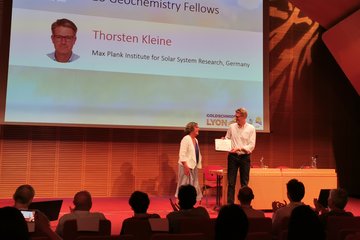Alle Typen
81.
Vortrag
Machine learning techniques for forecasting the magnetospheric plasma conditions using Cluster RAPID data. 29th Cluster workshop, Lanzarote, Canary Islands, Spain (2019)
82.
Vortrag
Evolution of energetic electron intensities in the radiation belts measured by Cluster/RAPID during 1.5 solar cycles. 29th Cluster workshop, Lanzarote, Canary Islands, Spain (2019)
83.
Vortrag
Internally triggered substorms: Jupiter and Earth. 14th International Conference on Substorms, Tromsø, Norway (2019)
84.
Vortrag
Report for the SREM Experiment. Rosetta Archive Enhancement Data Closeout Review, Madrid, Spain (2019)
85.
Vortrag
On the role of heavy energetic ions for the dynamics of the magnetosphere: Cluster observations. Ion Composition in the Sun Earth System (ICSES), Durango, USA (2019)
86.
Vortrag
Energy transformation, turbulence and acceleration in space plasmas: why it is cool to be together? VWS Symposium, Dresden, Germany (2019)
87.
Vortrag
Energetic ions in the near-Earth space: Cluster mission perspective. University of Illinois, Urbana-Champaign, USA (2019)
88.
Vortrag
Circulation of heavy ions and their impact on magnetic storms and substorms. RAS Specialist Discussion Meeting, London, UK (2019)
89.
Vortrag
Cluster RAPID data computed in adiabatic invariant coordinates: A long-term data product for radiation belt research and data assimilation. 24th Cluster Cross-Calibration Workshop, Maspalomas, Gran Canaria, Spain (2018)
90.
Vortrag
RAPID ions vs CIS. 24th Cluster Cross-Calibration Workshop, Maspalomas, Gran Canaria, Spain (2018)
91.
Vortrag
Cross-calibration between electrons onboard Cluster and Arase. 24th Cluster Cross-Calibration Workshop, Maspalomas, Gran Canaria, Spain (2018)
92.
Vortrag
Calculation of L-Star. 24th Cluster Cross-Calibration Workshop, Maspalomas, Gran Canaria, Spain (2018)
93.
Vortrag
Electron intensity measurements in the radiation belts. 24th Cluster Cross-Calibration Workshop, Maspalomas, Gran Canaria, Spain (2018)
94.
Vortrag
Two methods to derive RAPID/IES long-term correction functions. 24th Cluster Cross-Calibration Workshop, Maspalomas, Gran Canaria, Spain (2018)
95.
Vortrag
Charged particles in the magnetosphere. Institute of Geology and Geophysics, Chinese Academy of Sciences, Beijing, China (2018)
96.
Vortrag
Circulation of heavy ions in the magnetosphere. 4th LMU-ChAN Scientific Forum, Peking, China (2018)
97.
Vortrag
The energetic particle properties in the magnetosphere: results based on statistics from Cluster/RAPID observations. 5th Cluster-Themis Workshop, Chania, Greece (2018)
98.
Vortrag
Estimating the Kinetic Energy Budget of the Polar Wind Outflow. 5th Cluster-Themis Workshop, Chania, Greece (2018)
99.
Vortrag
Sources of Soft X-rays in the magnetosphere. ISSI meeting “Soft Protons in the Magnetosphere focused by X-ray Telescopes”, Bern, Switzerland (2018)
100.
Vortrag
Comparing and contrasting dispersionless injections at geosynchronous orbit during a substorm event. COSPAR 2018, Pasadena, CA, USA (2018)











